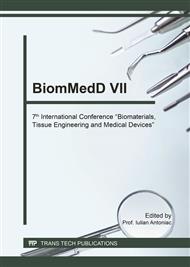p.11
p.18
p.24
p.29
p.35
p.41
p.49
p.54
p.59
The Efficiency of Endodontic Retreatment through Direct Crown Access
Abstract:
Endodontic retreatment with direct crown access is the main choice in cases of endodontic treatment failure, even if the practitioner`s effort and duration is significantly greater compared with other procedures. The retreatment with crown access repeats root canal treatment through direct access at the level of tooth crown. The objective is to clean up the canal from irritant agents, such as microorganisms, surviving from the previous therapy or passed through afterwards. Thus, a treatment restart is in accordance with the logics of root canal therapy and is preferred at any time if possible. The aim of this study was to observe, over a 4-year span, the efficiency of endodontic retreatment with direct coronary approach. From 2012 to 2016, 148 patients, with ages ranging from 18 to 65 years, were retreated endodontically. All patients were included in a regular monitoring plan of 3 months and 1-year post treatment. X-rays were performed during these observations, assessed with Orstavik criteria (1991), each radiography having assigned a periapical index (PeriApical Index – PAI). In conclusion, this study confirms that first choice of retreatment in case of endodontic treatment failure is restarting of the retreatment with direct crown access (91% success rate), failure of which leads to a surgical approach using endodontic microsurgery techniques.
Info:
Periodical:
Pages:
35-40
Citation:
Online since:
August 2017
Keywords:
Price:
Сopyright:
© 2017 Trans Tech Publications Ltd. All Rights Reserved
Share:
Citation:


